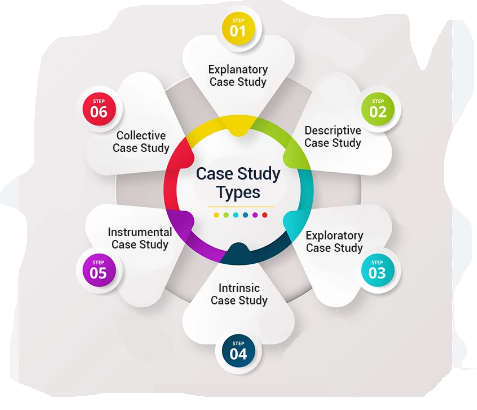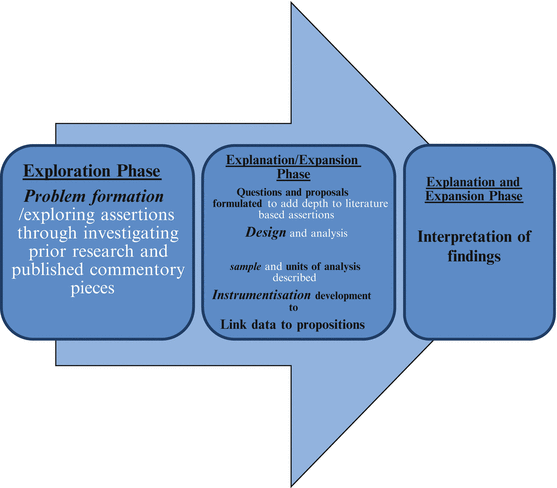TYPES OF CASE STUDIES

A case study is a research method used to conduct an in-depth analysis of a particular individual, group, event, organization, or phenomenon within its real-life context. It is a comprehensive and detailed investigation that seeks to understand and interpret the complexities and nuances of the subject under study.
In a case study, researchers typically gather data from various sources, such as interviews, observations, documents, and archival records, to provide a holistic understanding of the case. The goal is to gain insights into the unique characteristics, behaviors, processes, challenges, and outcomes related to the specific case.
Case studies are commonly used in social sciences, business, medicine, psychology, education, and other fields where researchers aim to explore real-world situations and draw meaningful conclusions based on empirical evidence.

Case studies can be of several types, each with its main features and examples. Here are some common types:
- Illustrative Case Studies:
Illustrative case studies, also known as descriptive case studies, are a type of qualitative research that provides a comprehensive and detailed account of a particular subject or event. The primary objective of an illustrative case study is to offer a clear and vivid portrayal of the subject, enabling readers or researchers to understand it better in its real-life context. These case studies are often used as introductory examples to explain a concept, theory, or situation to a broader audience.
Main Characteristics of Illustrative Case Studies:
- Description: The core feature of illustrative case studies is the detailed description of the subject under investigation. Researchers aim to present a comprehensive overview of the case without necessarily seeking to explain cause-and-effect relationships or draw broad generalizations.
- Real-Life Context: Illustrative case studies focus on real-life situations or events, making them valuable for understanding complex phenomena in their natural settings. By using real-world examples, they provide practical insights that can be relevant and applicable to similar situations.
- Limited Analysis: While some analysis might be present, the main emphasis is on describing the case rather than conducting an in-depth examination of underlying factors or causal relationships.
- Informative: Illustrative case studies are typically rich in data, presenting various details, observations, and qualitative information. They may use various sources of data, such as interviews, observations, documents, and archival records, to build a comprehensive narrative.

- Cross-Disciplinary Use: These case studies are widely used across different disciplines as teaching tools, research examples, or supporting evidence for theories and concepts.
Examples of Illustrative Case Studies:
- Business Management: An illustrative case study might focus on a successful company's growth story, detailing its strategies, marketing techniques, and innovative practices that contributed to its success.
- Education: A case study could describe how a particular school implemented a new teaching method, showcasing the changes in student performance and engagement.
- Psychology: An illustrative case study might present the life of an individual who overcame significant mental health challenges and highlight the factors that contributed to their recovery.
- Medicine: A case study might describe a patient's medical journey, including symptoms, diagnosis, treatment, and outcomes, to illustrate a rare disease or a unique approach to treatment.
- Sociology: An illustrative case study could delve into the experiences and impact of a community-based initiative aimed at reducing crime rates in a specific neighborhood.
- Environmental Science: A case study might explore how a city successfully transitioned to renewable energy sources, showcasing the policies and measures implemented to achieve sustainability.
- Exploratory Case Studies:
Exploratory case studies are a type of research design used when there is limited existing knowledge or understanding of a particular subject or phenomenon. The main objective of exploratory case studies is to explore and gain insights into the research topic, generate hypotheses, and develop a deeper understanding of the complexities involved. These studies are often preliminary and serve as a foundation for more extensive research in the future.
Key Characteristics of Exploratory Case Studies:
- No Predefined Hypotheses: Unlike other types of case studies, exploratory case studies do not start with specific hypotheses or predictions. Instead, they are more open-ended and allow researchers to identify potential patterns or themes during the data collection and analysis process.
- Flexible Research Design: The research design in exploratory case studies is flexible and adaptive. Researchers can modify their approach based on emerging findings, allowing them to delve deeper into areas that show promise.
- Qualitative Approach: Exploratory case studies usually rely on qualitative data collection methods, such as interviews, focus groups, observations, and document analysis. These methods help researchers gather rich, in-depth data to gain a comprehensive understanding of the subject.
- Small Sample Size: Exploratory case studies typically involve a relatively small number of cases or participants. The emphasis is on obtaining detailed information rather than achieving statistical representativeness.
- Inductive Analysis: In exploratory case studies, researchers often use an inductive approach to analyze the data. They look for patterns, themes, and trends that emerge from the information gathered and use them to develop theories or hypotheses.
- Formulation of New Research Questions: As the study progresses, new research questions may emerge that were not initially anticipated. Exploratory case studies are conducive to this kind of iterative research process.

Examples of Exploratory Case Studies:
- Exploring the Adoption of Renewable Energy Technologies: Researchers conduct interviews with residents in a rural community to understand their perspectives on renewable energy adoption. The goal is to identify barriers and facilitators to the adoption of solar panels and wind turbines.
- Investigating the Impact of Social Media on Mental Health: A researcher conducts focus group discussions with teenagers to explore how social media usage affects their mental health and well-being. The study aims to uncover potential patterns and themes in their experiences.
- Understanding the User Experience of a New Mobile App: Usability researchers conduct observations and interviews with users interacting with a newly developed mobile app. The study aims to identify usability issues and gather feedback to improve the app's design.
- Exploring the Perceptions of Teachers on Inclusive Education: Researchers conduct semi-structured interviews with teachers from different schools to gain insights into their perceptions, challenges, and experiences related to inclusive education practices.
- Explanatory Case Studies:
Main Features: These case studies focus on explaining cause-and-effect relationships and explore why a particular outcome occurred.
Example: An in-depth analysis of a marketing campaign that led to a significant increase in sales for a company.
- Instrumental Case Studies:
Main Features: In instrumental case studies, the subject is chosen for its unique and specific characteristics, providing an opportunity to study a particular phenomenon in detail.
Example: Studying a specific hospital's successful implementation of patient care protocols to identify best practices that can be applied in other healthcare settings.
Main Features: These studies involve the examination of multiple cases to draw broader conclusions or patterns across them.
Example: A research project comparing the experiences and outcomes of several different schools that implemented a new teaching methodology.

Main Features: In this type, the case itself is of interest due to its uniqueness or rare characteristics.
Example: An investigation into the life and work of a prominent historical figure to understand their impact on society.
- Longitudinal Case Studies:
Main Features: Longitudinal case studies involve the examination of a subject over an extended period to observe changes and developments over time.
Example: A study tracking the career trajectories and job satisfaction of a group of employees within a company over ten years.
- Critical Instance Case Studies:
Main Features: Critical instance studies focus on analyzing a particularly significant event or turning point that has a profound impact on the subject.
Example: Analyzing the response of a city's emergency services to a natural disaster to identify areas for improvement in disaster preparedness.
- Program Implementation Case Studies:
Main Features: These studies assess the implementation and execution of a specific program or intervention and evaluate its effectiveness.
Example: Evaluating the outcomes of a community-based health initiative aimed at reducing childhood obesity rates.

Case studies provide valuable insights and context-rich data, making them a powerful research tool in various fields. Researchers carefully design case studies to answer specific research questions and provide in-depth knowledge about complex phenomena.
